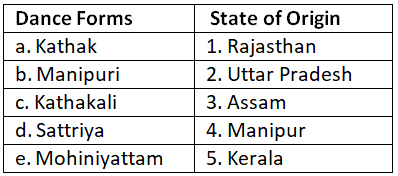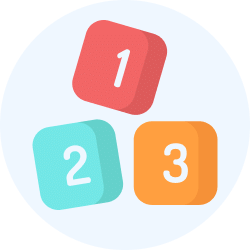Worksheet: Dance Forms Classical | General Knowledge for Young Learners - Class 1 PDF Download
| Table of contents |

|
| Section A: Multiple Choice Questions |

|
| Section B: Short Questions |

|
| Section C: Fill in the Blanks |

|
| Section D: Match the Column |

|
| Section E: True or False |

|
Section A: Multiple Choice Questions
Q1: Which dance form originated in India?
(a) Ballet
(b) Kathakali
(c) Flamenco
(d) Salsa
Q2: Which dance form is known for its intricate footwork and graceful hand movements?
(a) Bharatanatyam
(b) Tap dance
(c) Hip-hop
(d) Tango
Q3: Which dance form originated in the state of Odisha, India?
(a) Kathak
(b) Kuchipudi
(c) Manipuri
(d) Odissi
Q4: Which dance form is characterized by its spinning movements and colorful costumes?
(a) Kathakali
(b) Salsa
(c) Contemporary dance
(d) Bhangra
Q5: Which dance form originated in the northern parts of India and is often performed with ghungroos (musical anklets)?
(a) Bharatanatyam
(b) Kathak
(c) Salsa
(d) Flamenco
Section B: Short Questions
Q1: Name two classical dance forms of India.
Q2: Where did Bharatanatyam originate from?
Q3: What is the traditional costume worn in Kathakali?
Q4: Which classical dance form is associated with Lord Krishna?
Q5: What is the main musical instrument used in Kathak?
Section C: Fill in the Blanks
Q1: Bharatanatyam is a classical dance form from the state of ____________.
Q2: Kathakali is a traditional dance form from the state of ____________.
Q3: Odissi is a classical dance form from the state of ____________.
Q4: The classical dance form Kuchipudi originated in the state of ____________.
Q5: Mohiniyattam is a classical dance form from the state of ____________.
Section D: Match the Column

Section E: True or False
Q1: Bharatanatyam is a classical dance form from Rajasthan.
Q2: Kathakali is a classical dance form from Kerala.
Q3: Odissi is a classical dance form from Karnataka.
Q4: Kuchipudi is a classical dance form from Andhra Pradesh.
Q5: Mohiniyattam is a classical dance form from Maharashtra.
You can access the solutions to this worksheet here.
|
64 videos|153 docs|40 tests
|
FAQs on Worksheet: Dance Forms Classical - General Knowledge for Young Learners - Class 1
| 1. What are the main types of classical dance forms covered in the curriculum for Class 1? |  |
| 2. Why is it important for students to learn about classical dance forms at a young age? |  |
| 3. How can parents support their children in learning classical dance forms? |  |
| 4. What are some basic elements of classical dance that students will learn in Class 1? |  |
| 5. How can students showcase what they have learned in classical dance forms? |  |















